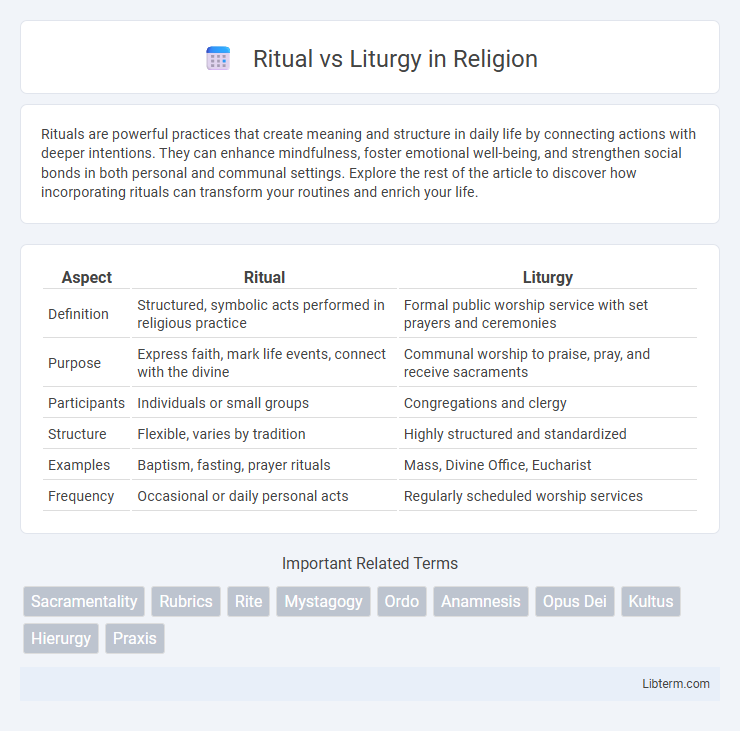Rituals are powerful practices that create meaning and structure in daily life by connecting actions with deeper intentions. They can enhance mindfulness, foster emotional well-being, and strengthen social bonds in both personal and communal settings. Explore the rest of the article to discover how incorporating rituals can transform your routines and enrich your life.
Table of Comparison
| Aspect | Ritual | Liturgy |
|---|---|---|
| Definition | Structured, symbolic acts performed in religious practice | Formal public worship service with set prayers and ceremonies |
| Purpose | Express faith, mark life events, connect with the divine | Communal worship to praise, pray, and receive sacraments |
| Participants | Individuals or small groups | Congregations and clergy |
| Structure | Flexible, varies by tradition | Highly structured and standardized |
| Examples | Baptism, fasting, prayer rituals | Mass, Divine Office, Eucharist |
| Frequency | Occasional or daily personal acts | Regularly scheduled worship services |
Understanding Ritual and Liturgy: Key Differences
Ritual refers to a set of prescribed actions performed for symbolic or religious purposes, often personalized or cultural, while liturgy is a formalized public worship service structured around established religious traditions. Rituals emphasize individual or communal symbolic acts, whereas liturgy involves organized, repetitive ceremonies guided by ecclesiastical authority. Understanding the distinction highlights how rituals can be flexible and varied, whereas liturgy maintains consistent patterns to unify congregational worship.
Historical Origins of Rituals and Liturgies
Rituals and liturgies both trace their origins to ancient religious and cultural practices, with rituals generally predating formal liturgies as spontaneous acts symbolizing communal values or beliefs. Early rituals often involved rites of passage, seasonal ceremonies, or tribal customs, evolving into structured liturgies as organized religions codified worship patterns to ensure uniformity and doctrinal consistency. Liturgy emerged prominently in early Christianity and Judaism, formalizing prayers, sacraments, and ceremonies, distinguishing itself from more fluid, localized rituals through scripted texts and prescribed rites.
Theological Foundations: Ritual vs. Liturgy
Ritual and liturgy differ fundamentally in their theological foundations, with ritual emphasizing symbolic actions that convey spiritual meanings and facilitate personal or communal transformation within various religious traditions. Liturgy, rooted in formalized worship structures, embodies organized, communal practices that reflect and reinforce core doctrinal beliefs and divine order. The theological basis of liturgy ensures continuity and uniformity in worship, while ritual allows flexibility and interpretive depth in religious experience.
Purpose and Function in Worship
Ritual in worship serves as a structured, symbolic act designed to evoke a spiritual experience and reinforce communal beliefs, often emphasizing emotional connection and personal devotion. Liturgy functions as an organized form of public worship, following a set order of prayers, readings, and sacraments that uphold doctrinal consistency and facilitate collective participation. Both ritual and liturgy play essential roles in shaping religious identity by providing frameworks for expressing faith and fostering spiritual discipline.
Structure and Form: Rituals Compared to Liturgies
Rituals typically exhibit flexible structures tailored to specific cultural or personal contexts, while liturgies follow a fixed, formalized sequence prescribed by religious traditions. Rituals often involve symbolic actions and gestures that can vary in execution, whereas liturgies maintain standardized prayers, readings, and ceremonies performed consistently across congregations. The structured formality in liturgies aims to unify participants through shared, time-honored patterns, contrasting with the adaptability and variation seen in many ritual practices.
Symbolism and Meaning in Both Practices
Rituals utilize symbolic actions and objects to convey personal or communal meanings, often emphasizing transformation and connection through repeated gestures and ceremonies. Liturgy incorporates formalized, structured symbolism within religious worship, aiming to express doctrinal beliefs and facilitate communal participation in sacred narratives. Both practices rely on symbols as carriers of meaning, but rituals tend to be more fluid and adaptable, whereas liturgies maintain established patterns that reinforce theological significance.
Examples Across World Religions
Rituals such as the Hindu Puja, involving offerings to deities, contrast with liturgies like the Catholic Mass, which follows a structured sequence of prayers and readings. In Islam, the daily Salah prayers represent a ritual performed individually or in congregation, while the liturgical elements are evident during the Friday Jumu'ah service with its specific sermon and recitations. Similarly, in Judaism, Passover Seder includes ritual acts symbolizing liberation, whereas the liturgical framework is observed in the synagogue service with fixed prayers like the Amidah and Torah readings.
Community Participation and Individual Experience
Rituals emphasize personal involvement, allowing individuals to actively engage and find personal meaning, thereby fostering a sense of spiritual connection within the community. Liturgy follows a structured, communal format that unites participants through shared prayers and prescribed actions, reinforcing collective identity and tradition. Community participation in rituals tends to be flexible and emotionally driven, while liturgy prioritizes uniformity and collective worship experience.
Evolution and Adaptation Over Time
Rituals have evolved from archaic, repetitive actions tied closely to myth and tradition into more personalized and dynamic expressions of cultural identity, while liturgies have adapted through codification and formalization to preserve doctrinal consistency within religious institutions. Both practices demonstrate flexibility, with rituals often incorporating contemporary symbols and media, and liturgies undergoing revisions to address modern linguistic and theological sensibilities. Their evolution reflects broader societal changes, balancing continuity with innovation to maintain relevance across diverse communities and historical periods.
The Impact on Spiritual Life and Faith
Rituals create a personal, emotional connection to spirituality by allowing individuals to engage in symbolic acts that reinforce their beliefs and values. Liturgy offers a structured, communal worship experience that fosters unity and continuity within faith communities through prescribed prayers and ceremonies. Both significantly shape spiritual life by deepening faith, providing meaning, and sustaining religious identity.
Ritual Infographic

 libterm.com
libterm.com